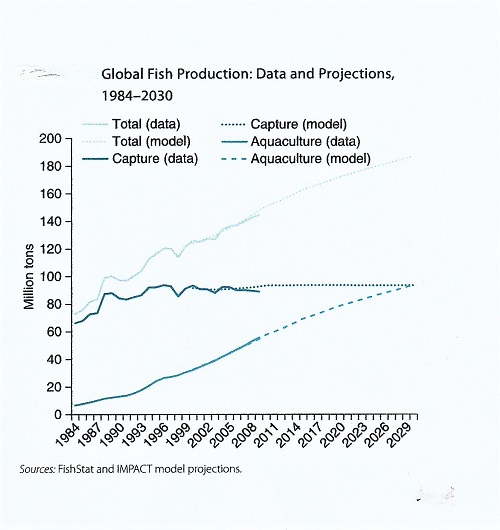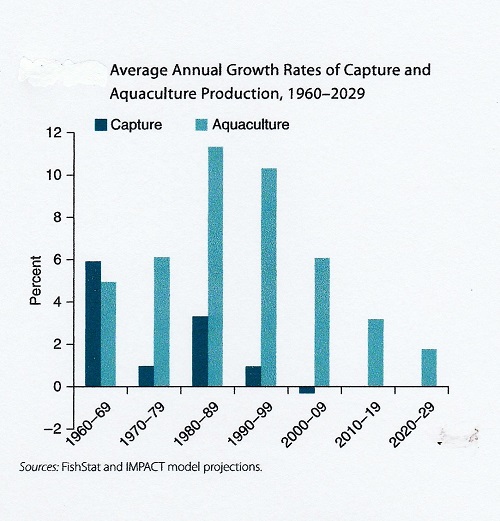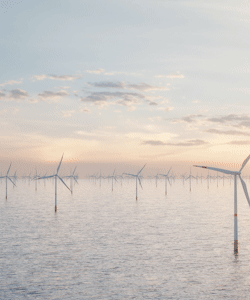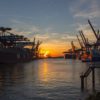Between 2008 and 2013, 40 % of the increase in consumption is due to the increase in population, but 60 % is due to the general increase in revenue. In this period the global consumption per capita increased from 18 to 20 kg / year (FAO nº 607).
The distribution of the fish consumption in 2013 shows strong regional disparities: Asia 70 %, Europe 11.6 %, the Americas 9,8 %, Africa 7.8 % and Oceania 0.8 %.
The expected evolution consumption for 2030 of the sea fish, freshwater fish, diadromes, crustaceans, molluscs and cephalopods have been estimated on 186.3 millions tons / year (FISH TO 2030, World Bank 2013).
In this projection, it’s evident the increase of the chinese consumption, due not to the populational growth that will be of only 3.4 % in that period, but instead due to the increase in the domestic product of 177.0 %, that will lead to a fish consumption of about 53.2 millions tons / year. For India the predicted increase for the GIP in this period is 92.6 % and to the Southeast Asian Countries 88.4 %, with the inherent predictable consequences to the fish consumption.
In the same period, the study points to the consumption stability for the Europe and Central Asia, some decrease in the Americas and Japan and a moderate increase in Africa. That means stability or slight decrease in the developed countries and a variable strong increase in the developing countries.
Worth refering that regarding the 2010 data, 38 % of the produced fish have been exported, 67 % of which coming from developing countries, which clearly shows how global this market is, whith a high degree of integration and where everyting that happens has impacts on all the members. This means that all the problems that we can foresee to the future, arround problems of eventual scarcity of the offer and the increase of the prices, are not only an asian problem but will have strong incidence at regions like Europe higly dependent of imports.
To go further ahead and foresee the scenario for 2050, in the absence of specific analysis, the only possibility, despite its inherent fragility, consists in extrapoling the data calculated for 2030. For that, we prefer a very conservative perspective only looking to the global populational increase and not taking in consideration the increases corresponding to the improvement of the standart of living of the population.
As such, considering that the estimated global population in 2030 is around 8.3 billion people, and that in 2050 will be, according the United Nations, around 9.7 billion people, we can consider that the consumption of the various categories of fish that have been considering, will be around 218 million ton / year in 2050 [2].
It´ s important to mention that this tendancy for the consumption of fish occurs in a context where the increase of the meat production is very limited by the shortage of land and water and by the less efficiency regarding the food conversion. So that, fish consumption is the inescapable alternative to meat.
Global Fish production estimates in medium and long term
Looking from the point of view of the global fish production, we must find out that there are an evolution on the production paradigms. In a context of an easy disposal of sites to produce inshore and of cheap and plentiful manpower, the answer of the production to the market solicitations have been done but with some structural adaptations.
In only twenty years, from 1993 to 2013, besides a great increase in the consumption, there was a very significant variation in its composition. The sea fish that used to represent 52.6 % of the consumption in 1993, decreased to 36,7 % in 2013. On the other hand, fresh water fish and diadromes which used to represent 22.9 % increased to 37,9 % (FAO nº 607). This can be explained by the stagnation of fishing at sea, but also by the small increase of the marine aquaculture at the seashore, due to the lack of protected locations for that. Despite this, aquaculture in fresh water and in estuaries increased significantly, whith a particular incidence in China which currently represents almost 50 % of the global aquaculture production, whith a particular incidence in the production of fresh water fish of around 25 million ton / year (carp and tilapia). Others countries of the Asia-Pacific Region also contribute for this predominance of aquaculture in freshwater and estuaries (Pangasius).
According to FAO (Doc. nº 607), from 2015 to 2020 the potencial increases in consumption will be of 11.2 million ton / year for sea fish and 15.8 million ton / year for freshwater fish and diadromes. These values were adquired through a linear regression which uses specific coeficientes of demand elasticity, regarding the revenue and the price, for each kind of fish considered. These coeficients are used for short term evaluation because they will change over the time.
However, in this study where have been considering the stimulant effect of the prices and the existing production capabilities in each case, it is verified the impossibility to ensure the demands of the consumption.
The gap is particulary serious in respect to sea fish production, with a predicted increase of only 500 000 ton, creating a deficit of around 10.7 million tons, owing to the inability of the infrastructures to answer the demand. The plausible explanation remains in the fact that mariculture is limited to the protected areas regarding the marine agitation, which are rare in a global context, and are pratically occupied, at least the ones which have accessibility to the market.
The role to be played by the offshore aquaculture
The following graphic shows the growth rates relative to fishing and aquaculture verified since 1960 until now, and according to previsions made until 2029.
The decrease of the capture is not a novelty and probably will deacrease in the futur more than is considered in the graph.
Regarding aquaculture, the rates verified from 1980 to 2009, despite the decreasing, have allowed the rising development of aquaculture production. In fact, they have varied between 11 and 6 % during that time frame, but were applied to bases of a rising annual value. Still, the foreseen decrease for the current decade for 3 % and, even more importantly, what is predicted for 2020 – 2029, less than 2%, decisively compromises the contribution of aquaculture to the high levels of demand as we have been referring, which imposes for the production growth rates much hight for it, to be possible to ensure the great growing demand (9.9 % for the period from 2015 to 2020 as refered by FAO nº 607).
So, the only possible conclusion, that is important to emphasise, is that the authors of the World Bank study clearly testify the inexistence of the offshore exploration nowadays. But express also the non consideration for the future of the offshore aquaculture contribution for the solution of this problem, attitude which is urgent to correct, once only the investment in offshore aquaculture can make the difference inverting this tendency.
The main actual contribution to the fish production through the aquaculture are the fresh water sistems, that in China has, among others expressions, the tipical configuration of paddy-fields where at the flooded beds, the rice plants are cultivated together with carps and ducks. Considering that the increasing rural exodus currently happening in China will lead to the progressive desertion of these cultivated fields or, to an alteration on the technology, to attain higher rice productivity, in which the cultivation will begin using herbicides which will prevent the fish production, we can foresee why there is predictable a decrease, and not an increase in freshwater fish production.
In short, once the marine aquaculture growth in protected areas appears neglectable by the unavailability of those places, the increasing production that must be attained to satisfy the potencial demand at a global level, in medium and long term, must be faced as an objective for offshore aquaculture.
Available spaces for the practice of Offshore Aquaculture
It remains to know if there are available spaces to the aquaculture offshore and where are they located.
The excelent publication A global assessement of offshore mariculture potential from a spatial perspective (FAO nº 549) where is made the inventory in a global scale of the adequate spaces for offshore aquaculture production, gives the answer.
Using geographical information systems available in a global scale, the study proceeds by successive phases for the identification of the areas where offshore activity will be feasible.
On what concerns the fish production shows the world possibilities for Cobia and Salmon as representative species to cultivate. As can be constated at the figure, the use of only 5 % of the identificated areas covers the space needed by Offshore Aquaculture for the production of fish until 2050.
Offshore aquaculture technology
The equipments that are being developed to enable the fish production at the high energy environment that characterises the open sea situations, can be classified as hard or soft solutions.
One example of the first case is the world’s largest autonomous cage, an Oil &Gas technology adapted to the fishfarm. With a volume of 250 000 m3 and a producing capacity just to 7 500 tons by batch, is a solution adapted to some norvergean fishfarms that are the largests in the world.
At OFISEQ – Offshore Fishfarming Equipments, Lda we are developing feeding platforms and cages, with dimensions adapted to several types of fishfarms, that can withstand the most severe storms by submerging just to 30 / 40 m deep where the surface agitation is not perceived.
[2]Considering the effect of the revenue increases with the same impact that have been verified between 2008-3013 (FAO nº 607) the consumption in 2050 would be around 265 million ton / year.















